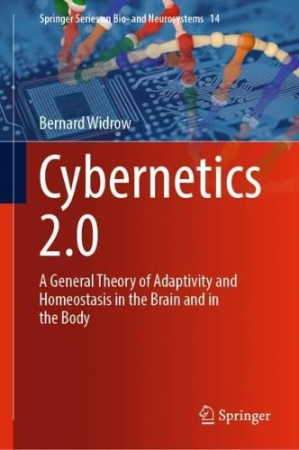English [en], .pdf, 🚀/lgli/lgrs/nexusstc/zlib, 6.4MB, 📘 Book (non-fiction), nexusstc/Cybernetics 2.0: A General Theory of Adaptivity and Homeostasis in the Brain and in the Body/0f7e023a31a8b6e50928bc4a39bb0a5c.pdf
Cybernetics 2.0: A General Theory of Adaptivity and Homeostasis in the Brain and in the Body (Springer Series on Bio- and Neurosystems, 14) 🔍
Springer International Publishing AG, Springer Series on Bio- and Neurosystems, Springer Series on Bio- and Neurosystems, 1, 2023
Bernard Widrow 🔍
description
This book takes the notions of adaptivity and learning from the realm of engineering into the realm of biology and natural processes. It introduces a Hebbian-LMS algorithm, an integration of unsupervised Hebbian learning and supervised LMS learning in neural networks, as a mathematical representation of a general theory for synaptic learning in the brain, and adaptation and functional control of homeostasis in living systems. Written in a language that is able to address students and scientists with different backgrounds, this book accompanies readers on a unique journey through various homeostatic processes in living organisms, such as body temperature control and synaptic plasticity, explaining how the Hebbian-LMS algorithm can help understand them, and suggesting some open questions for future research. It also analyses cell signalling pathways from an unusual perspective, where hormones and hormone receptors are shown to be regulated via the principles of the Hebbian-LMS algorithm. It further discusses addiction and pain, and various kinds of mood disorders alike, showing how they can be modelled with the Hebbian-LMS algorithm. For the first time, the Hebbian-LMS algorithm, which has been derived from a combination of Hebbian theory from the neuroscience field and the LMS algorithm from the engineering field of adaptive signal processing, becomes a potent model for understanding how biological regulation works. Thus, this book is breaking new ground in neuroscience by providing scientists with a general theory for how nature does control synaptic learning. It then goes beyond that, showing that the same principles apply to hormone-mediated regulation of physiological processes. In turn, the book tackles in more depth the concept of learning. It covers computer simulations and strategies for training neural networks with the Hebbian-LMS algorithm, demonstrating that the resulting algorithms are able to identify relationships between unknown input patterns. It shows how this can translate in useful ideas to understand human memory and design cognitive structures. All in all, this book offers an absolutely, unique, inspiring reading for biologists, physiologists, and engineers, paving the way for future studies on what we could call the nature’s secret learning algorithm.
Alternative filename
lgrsnf/Cybernetics_2.0_2023.pdf
Alternative filename
lgli/Cybernetics_2.0_2023.pdf
Alternative title
Cybernetics 2. 0 : A General Theory of Adaptivity and Homeostasis in the Brain and in the Body
Alternative author
Widrow, Bernard
Alternative publisher
Springer Nature Switzerland AG
Alternative edition
Springer series on bio- and neurosystems, Volume 14, Cham, Switzerland, 2023
Alternative edition
Springer Series on Bio- and Neurosystems Ser, v.14, Cham, 2022
Alternative edition
Springer series on bio- and neurosystems, S.l, 2022
Alternative edition
Springer Nature, Cham, 2022
Alternative edition
Switzerland, Switzerland
Alternative edition
1st ed. 2023, 2022
metadata comments
{"container_title":"Springer Series on Bio- and Neurosystems","edition":"1","isbns":["3030981398","3030981401","9783030981396","9783030981402"],"issns":["2520-8535","2520-8543"],"last_page":307,"publisher":"Springer","series":"Springer Series on Bio- and Neurosystems","source":"crossref"}
date open sourced
2022-10-16
🚀 Fast downloads
Become a member to support the long-term preservation of books, papers, and more. To show our gratitude for your support, you get fast downloads. ❤️
- Option #1: Fast Partner Server #1 (recommended) (open in viewer) (no redirect) (no browser verification or waitlists)
- Option #2: Fast Partner Server #2 (open in viewer) (no redirect)
- Option #3: Fast Partner Server #3 (open in viewer) (no redirect)
- Option #4: Fast Partner Server #4 (open in viewer) (no redirect)
- Option #5: Fast Partner Server #5 (open in viewer) (no redirect)
- Option #6: Fast Partner Server #6 (open in viewer) (no redirect)
🐢 Slow downloads
From trusted partners. More information in the FAQ. (might require browser verification — unlimited downloads!)
- Option #1: Slow Partner Server #1 (slightly faster but with waitlist)
- Option #2: Slow Partner Server #2 (slightly faster but with waitlist)
- Option #3: Slow Partner Server #3 (no waitlist, but can be very slow)
- After downloading: Open in our viewer
External downloads
All download options have the same file, and should be safe to use. That said, always be cautious when downloading files from the internet, especially from sites external to Anna’s Archive. For example, be sure to keep your devices updated.
-
For large files, we recommend using a download manager to prevent interruptions.
Recommended download managers: JDownloader -
You will need an ebook or PDF reader to open the file, depending on the file format.
Recommended ebook readers: Anna’s Archive online viewer, ReadEra, and Calibre -
Use online tools to convert between formats.
Recommended conversion tools: CloudConvert -
You can send both PDF and EPUB files to your Kindle or Kobo eReader.
Recommended tools: Amazon‘s “Send to Kindle” and djazz‘s “Send to Kobo/Kindle” -
Support authors and libraries
✍️ If you like this and can afford it, consider buying the original, or supporting the authors directly.
📚 If this is available at your local library, consider borrowing it for free there.
Total downloads:
A “file MD5” is a hash that gets computed from the file contents, and is reasonably unique based on that content. All shadow libraries that we have indexed on here primarily use MD5s to identify files.
A file might appear in multiple shadow libraries. For information about the various datasets that we have compiled, see the Datasets page.
For information about this particular file, check out its JSON file. Live/debug JSON version. Live/debug page.
